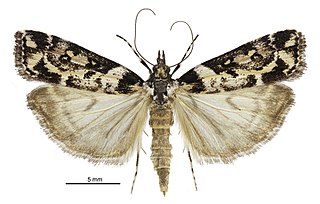
The herald is a moth of the family Erebidae. The species was first described by Carl Linnaeus in his 1758 10th edition of Systema Naturae. It is found throughout the Palearctic and Nearctic (Holarctic).

Euchaetis rhizobola is a moth of the family Oecophoridae. It is found in Australia, including New South Wales, Queensland, the Australian Capital Territory, Victoria, South Australia and Western Australia.

Spaelotis ravida, the stout dart, is a moth of the family Noctuidae. The species was first described by Michael Denis and Ignaz Schiffermüller in 1775. It is found in the Palearctic realm.

Eudonia diphtheralis is a species of moth in the family Crambidae. It is endemic to New Zealand.

Cosmopterix scirpicola is a moth of the family Cosmopterigidae. It is known from the United States, where found from Maryland and eastern Wyoming to Florida, south-western Louisiana and California. It has also been recorded from Alabama.

Cosmopterix lienigiella is a moth of the family Cosmopterigidae. It is found from Fennoscandia to Spain, the Alps and Greece and from Ireland to Ukraine. It is also present in eastern Russia and Japan. It is the type species of the genus Cosmopterix.
Chrysocentris chrysozona is a moth in the family Glyphipterigidae. It is from South Africa.

Cochylis dubitana, the little conch, is a moth of the family Tortricidae. It is found in China (Heilongjiang) and most of Europe. and the Caucasus. It is also found in North America, where it has been recorded from Colorado, Maine, Ontario and Washington.
Helcystogramma bicuneum is a moth in the family Gelechiidae. It was described by Edward Meyrick in 1911. It is known from north-eastern India and China.

Scrobipalpa obsoletella, the summer groundling, is a moth of the family Gelechiidae. It is found in most of Europe, Turkey, the Caucasus, from Iran to Asian Russia (Transbaikal) and Mongolia. It has also been recorded from South Africa and North America, where it is probably an introduced species. The habitat consists of coastal salt marshes and sandy beaches.

Ichneutica steropastis, or the flax notcher moth, is a species of moth in the family Noctuidae. It is endemic to New Zealand and can be found throughout the country from the Three Kings Islands to Stewart Island as well as in the Chatham Islands. New Zealand flax is a host plant for the larvae of this moth. Other larval host plants for this species include endemic species in the genus Austroderia as well as introduced species in the genus Cortaderia. In particular Austroderia fulvida, A. richardii and C. selloana are all recorded as larval host species of I. steropastis as is Poa foliosa. However the host plant is not a reliable guide to confirm the identification of this species as larvae of both I. arotis and I. blenheimensis also feed on similar hosts including flax species. The larvae are nocturnal, hiding away in the base of the plants and coming out to feed at night. They create a distinctive notch in the leaf when they feed. This damage ensures that the affected flax leaves cannot be used for weaving and so the larvae of this species are regarded as a pest.
Rhopalosetia is a monotypic moth genus in the family Copromorphidae. Its only species, Rhopalosetia phlyctaenopa, is found in French Guiana. Both the genus and species were first described by Edward Meyrick in 1926.
Gelechia epiphloea is a moth of the family Gelechiidae first described by Edward Meyrick in 1913. It is found in South Africa.
Empedaula phanerozona is a moth in the family Gelechiidae. It was described by Edward Meyrick in 1922. It is found in Brazil.
Antaeotricha neocrossa is a moth of the family Depressariidae. It is found in Peru.
Epiphractis aulica is a moth of the family Oecophoridae. This species was described from South Africa.
Stenoma caesia is a moth of the family Depressariidae. It is found in Guyana.
Peritornenta circulatella is a moth in the family Depressariidae. It was described by Francis Walker in 1864. It is found in Australia, where it has been recorded from the Northern Territory, Queensland and New South Wales.
Antaeotricha neurographa is a moth in the family Depressariidae. It was described by Edward Meyrick in 1922. It is found in Brazil.
Stenoma hyacinthitis is a moth in the family Depressariidae. It was described by Edward Meyrick in 1930. It is found in Guyana.






